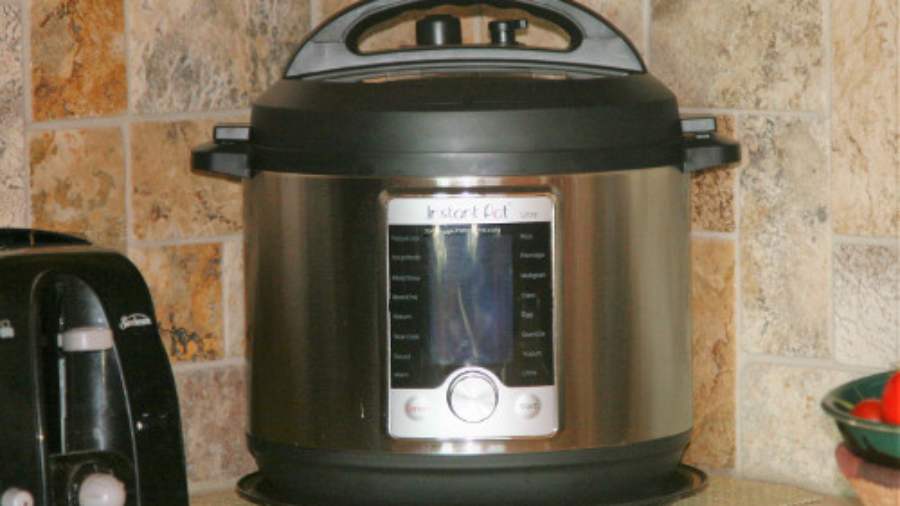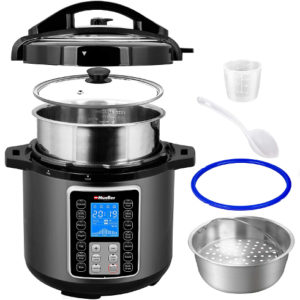 I recently got the INSTANT POT ULTRA (6-Quart) to use at my high elevation of 9,000 feet. Over the past 6 weeks or so I’ve experimented quite a bit with this and have found it to be a good choice for high elevation, but in different ways than advertised.
I recently got the INSTANT POT ULTRA (6-Quart) to use at my high elevation of 9,000 feet. Over the past 6 weeks or so I’ve experimented quite a bit with this and have found it to be a good choice for high elevation, but in different ways than advertised.
“HIGH ALTITUDE ADJUSTMENT”
The INSTANT POT ULTRA boasts a “High Altitude” feature. I’m glad I paid a little more to get this model, but not because of this feature. The high-altitude feature allows you to set your elevation in a system setting. The ULTRA description for this feature is misleading: it suggests that it “takes the guesswork out of recipe conversion”. This seems to imply that if I enter the time listed in a recipe, it will do the math for me and change the recipe time I’ve entered based on the elevation I’ve chosen. (Some independent reviewers have also indicated that it will do this.) It DOES NOT do this.
The only thing this adjustment does is change the amount of time for the pre-programmed buttons, such as RICE or PORRIDGE. So, if the PORRIDGE button sets 20 minutes by default at sea level, for my elevation the default time for that function is set at 27 minutes (35% more time added for 9,000 ft). That’s kind of nice, but not all that important for me since I usually follow recipes with their suggested timing rather than blindly push a button. I called IP Support and they verified that it only changes the pre-programmed button settings, NOT any manual times entered.
WHAT I LIKE ABOUT THE INSTANT POT ULTRA AT HIGH ELEVATION
 ULTRA “REMEMBERS”
ULTRA “REMEMBERS”
The Instant Pot Ultra will “remember” settings used previously. So, if I choose PORRIDGE and set it for my own time rather than the default, it will remember my setting the next time I use that program. So, even if I’m not happy with the factory pre-set time for my altitude, it will still remember my own preference.
ADJUSTABLE TEMPERATURES
Because water boils at a lower temperature here (195.5 F at this elevation), some things will boil at factory pre-sets in the Sauté or SLOWCOOK programs, when I would prefer a slow simmer. i.e. The HIGH setting for the Sauté mode is often too hot and some things will burn before they finish cooking (e.g. onions). The ULTRA will allow me to choose my own temperature setting: LOW, MED or HIGH, or my own CUSTOM choice. It is often better at high altitude to cook things longer at a lower temperature, rather than too fast at high temps.
FUNCTIONS
This model has a STEAM function that lets you choose whether you do or don’t want to use pressure. Some other models only use pressure for steaming. This model also provides the ULTRA function, which allows you to do just about anything you want, with or without pressure, any temperature you choose. The YOGURT function also allows a custom choice for temperature: I felt that the default temperature was too hot, and was able to choose my own heat.
FEATURES
I like the automatic locking feature of this model. No need to remember to seal before pressure cooking. There is also a nice “Quick Release” button which allows you to release the pressure easily, without getting your hand in the way of the steam.
WHAT I DON’T LIKE
DIAL (PRO AND CON)
The dial allows this model to provide many more functions, such as the ability to choose your own temperatures, but it takes a bit of getting used to. If you turn too fast, a couple of hours will skip by! When something is flashing, you need to press the dial, then turn it to change whatever flashes, then press the dial again to set. I make a lot of mistakes, but am catching on. I can understand the need for this dial to allow for so many of the customizable features available.
ACCESSORIES (LACK)
This (as with all other Instant Pots) does NOT include the very useful other accessories that some other brands include in the box.
MY CHOICE
I chose the INSTANT POT ULTRA after a brief encounter with another multicooker that did not provide all the customization that the ULTRA provides. This has been a great choice for my situation and my personal cooking needs. The INSTANT POT MAX also provides many of the same customizable settings, and there may be other multicookers out there that will do the same. Keep in mind that in choosing a multicooker to use at high elevation, it’s important that it provides the ability to make your own customization.
** Please read this post about USING INSTANT POTS AT HIGH ELEVATION for more detailed information.






